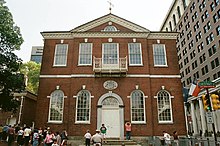2nd United States Congress
| 2nd United States Congress | |
|---|---|
|
1st ←
→ 3rd
|
|

Congress Hall (2007)
|
|
| March 4, 1791 – March 4, 1793 | |
| Senate President | John Adams (P) |
| Senate Pres. pro tem: |
Richard Henry Lee (P) John Langdon (P) |
| House Speaker: | Jonathan Trumbull, Jr. (P) |
| Members: | 28–30 (two additions) (with one vacancy) Senators 67–69 (two additions) (with 1-3 vacancies) Representatives |
| Senate Majority: | Pro-Administration, then Anti-Administration |
| House Majority: | Pro-Administration |
| Sessions | |
|
Special: March 4, 1791 – March 4, 1791 1st: October 24, 1791 – May 8, 1792 2nd: November 5, 1792 – March 2, 1793 (lame duck) |
|
The Second United States Congress, consisting of the United States Senate and the United States House of Representatives, met at Congress Hall in Philadelphia, Pennsylvania from March 4, 1791 to March 4, 1793, during the third and fourth years of George Washington's Presidency. The apportionment of seats in the House of Representatives was based on the provisions of Article I, Section 2, Clause 3 of the United States Constitution. Additional House seats were assigned to the two new states of Vermont and Kentucky. Both chambers had a Pro-Administration majority.
There were no political parties in this Congress. Members are informally grouped into factions of similar interest, based on an analysis of their voting record.
Details on changes are shown below in the "Changes in membership" section.
During this congress, two new Senate seats were added for each of the new states of Vermont and Kentucky.
During this congress, two new House seats were added for each of the new states of Vermont and Kentucky. (Sess. 3, ch. 9, 1 Stat. 191)
This list is arranged by chamber, then by state. Senators are listed in order of seniority, and Representatives are listed by district.
Senators were elected by the state legislatures every two years, with one-third beginning new six-year terms with each Congress. Preceding the names in the list below are Senate class numbers, which indicate the cycle of their election. In this Congress, Class 1 meant their term began in this Congress, requiring reelection in 1796; Class 2 meant their term ended with this Congress, requiring reelection in 1792; and Class 3 meant their term began in the last Congress, requiring reelection in 1794.
...
Wikipedia
